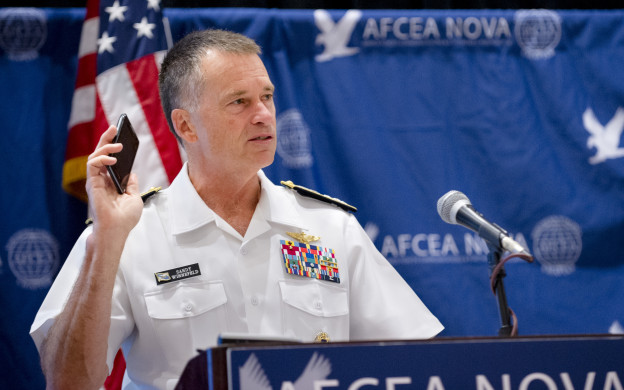
The vice chairman of the Joint Chiefs of Staff has some advice for the Army—struggling with future missions, fewer soldiers, and less money for training and modernization. It sounded very much like what he might say to the Marines: “I’d like to see the Army place more emphasis on the growth industry—protecting American citizens abroad.”
Adm. James Winnefeld added, “Don’t yield that entirely to the Marine Corps.”
Speaking on 12 September at the Association of the United States Army, he said that the Defense Department in its strategic guidance views the next fight—“and some day we will get in another fight on the ground”—as being different. It probably will be more along the lines of Desert Storm, where an ally or friend has been invaded. But it will be “shorter, faster-paced and much harder” because the enemy will be employing the tools the United States developed to increase “the fog of war.”
The tools include precision-guided weapons; better intelligence, surveillance and reconnaissance than enemies had in the recent past; and improved and secure networks.
Because of those changes, “the battlefield will be a more hostile environment than it’s ever been,” Winnefeld said. “We will need ground forces that can handle this.”
It also means that ground forces must be able to be deployed quickly, a challenge that has Army been wrestling with since the end of Desert Storm and the peace-enforcement operations in the Balkans in the middle and late 1990s.
That kind of war is very different from the counterinsurgency operations that the Army and Marine Corps employed in Afghanistan and Iraq, he said, although the United States could be supplying support to another nation waging its own counterinsurgency campaign.
Winnefeld said that this view of the future had “hedges” built in to “avoid institutional hubris” in reacting to changed circumstances. In answer to a question, he cited former Defense Secretary Robert Gates’ observation that “we hardly ever get this right” when planning for the future.
“We believe that the types of conflicts we would be in would be shorter than 10 or 12 years”—possibly more along the lines of the four years of combat in the American Civil War and its involvement in World War II.
If possible, “our political leadership has it in mind that they will do what they can to avoid a long war.”
During his address, Winnefeld also detailed fiscal problems facing the department in the coming fiscal year—a Continuing Resolution instead of a budget, the possibility of another round of sequestration cuts, limits on moving funds from one program to another, and a government shutdown. He said all had an impact on readiness.
“If you are a congressman that has an F-15 squadron in your district, you don’t really care if that squadron is flying or not as long as it’s there,” he said.





